Explore how programmatic SEO platforms like CMAX.ai automatically capture the 90% of untapped SEO traffic
The Programmatic SEO Solution That Delivers Exponential Growth On Autopilot
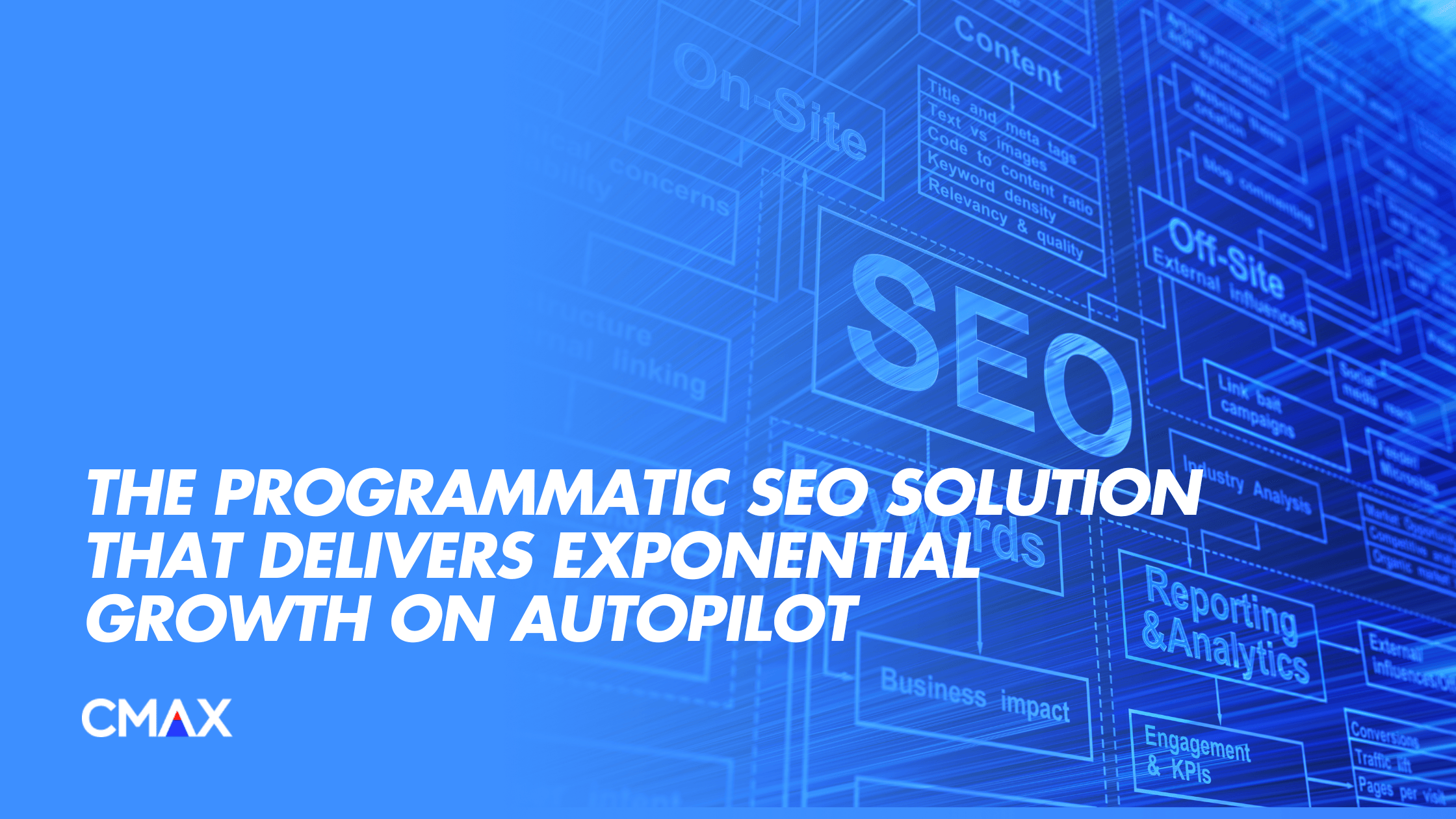

Explore how programmatic SEO platforms like CMAX.ai automatically capture the 90% of untapped SEO traffic
Most businesses obsess over a small fraction of their website – pages like the homepage and key product categories. These are the high-traffic, high-visibility areas that get the most attention. But chances are you’re missing out on a huge portion of your potential traffic – up to 90%, to be exact.
Full Body SEO is a strategy that broadens the scope of your optimization efforts to target not just the obvious pages, but the overlooked ones that hold the real traffic potential.
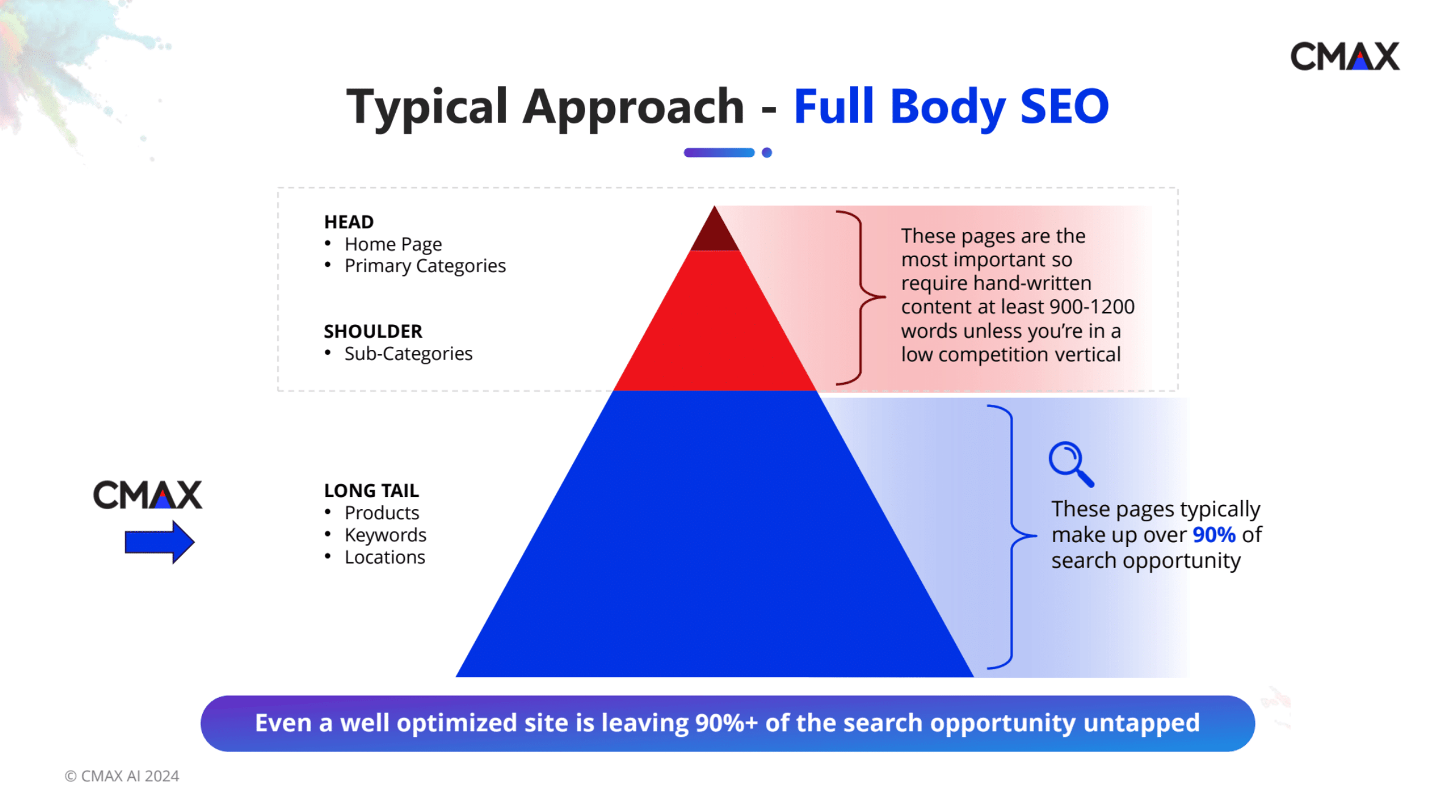
At the top of the SEO pyramid are your head pages, which include your homepage and primary categories. These are typically the most visited and, as a result, demand highly optimized content. To compete in a saturated market, these pages often need 900 to 1,200 words of detailed, handcrafted content. It’s where you should concentrate your initial efforts to establish authority in your niche.
Just below the head, we have the shoulder pages. These are your sub-categories that support your structure. They don’t usually require the same intense manual content effort as the primary pages and yet, they still play a significant role in guiding users and search engines through your site.
At the base of the pyramid, and often neglected, are your long tail pages, and these hold the real, untapped potential of your SEO efforts. And it’s because they reflect what people search for when they’re further along in their decision-making process. That means higher buyer intent with a greater potential for conversion.
The thing is, most businesses focus so much on their head terms that they miss out on this enormous traffic source.
Long tail keywords tend to be more specific and less competitive, but when aggregated, they can drive the majority of organic traffic to your site.
Let’s take a look at some keyword opportunities at different product categories.
For instance, if we look at the skin care space, the head term “skin care” gets over 90,000 searches a month in the US. But when you include the total volume for all related skin care terms, it’s over 3.7 million searches a month, spread across over 244,000 keywords.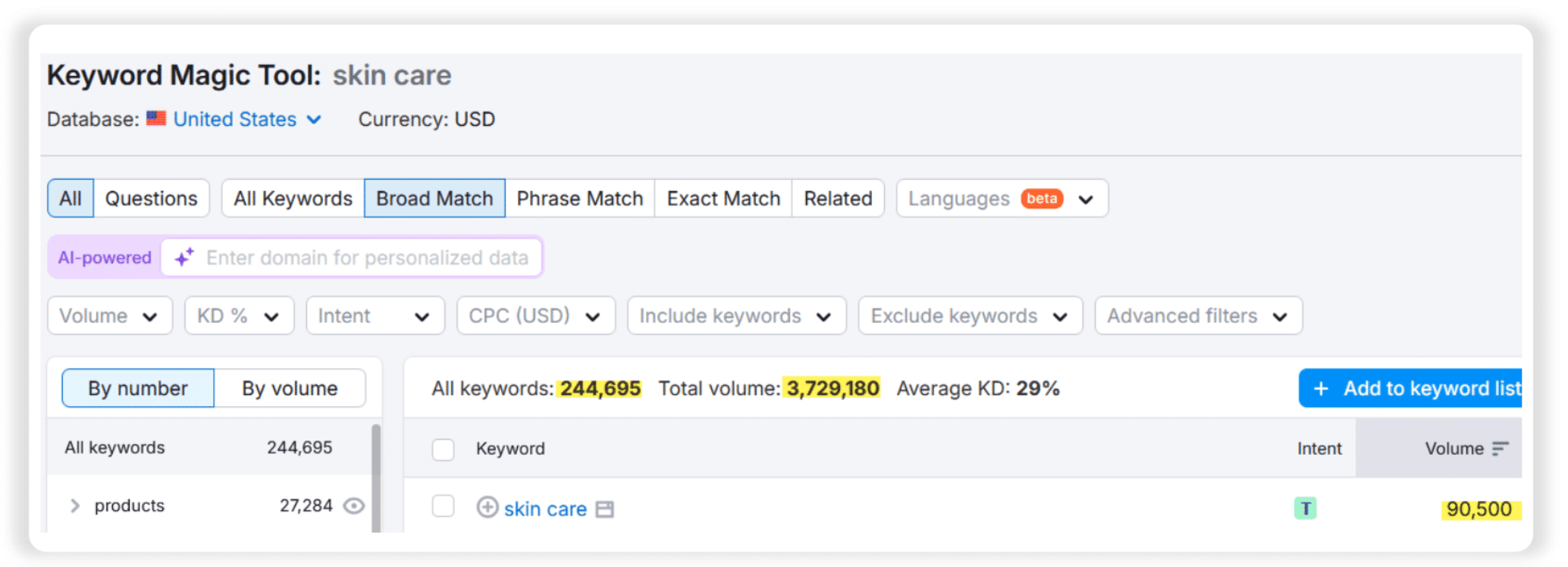
Similarly, the head term “diamond rings” is searched 49,000 times a month. However, the overall search volume related to diamond rings also exceeds 3.7 million searches, scattered across 149,000 keywords.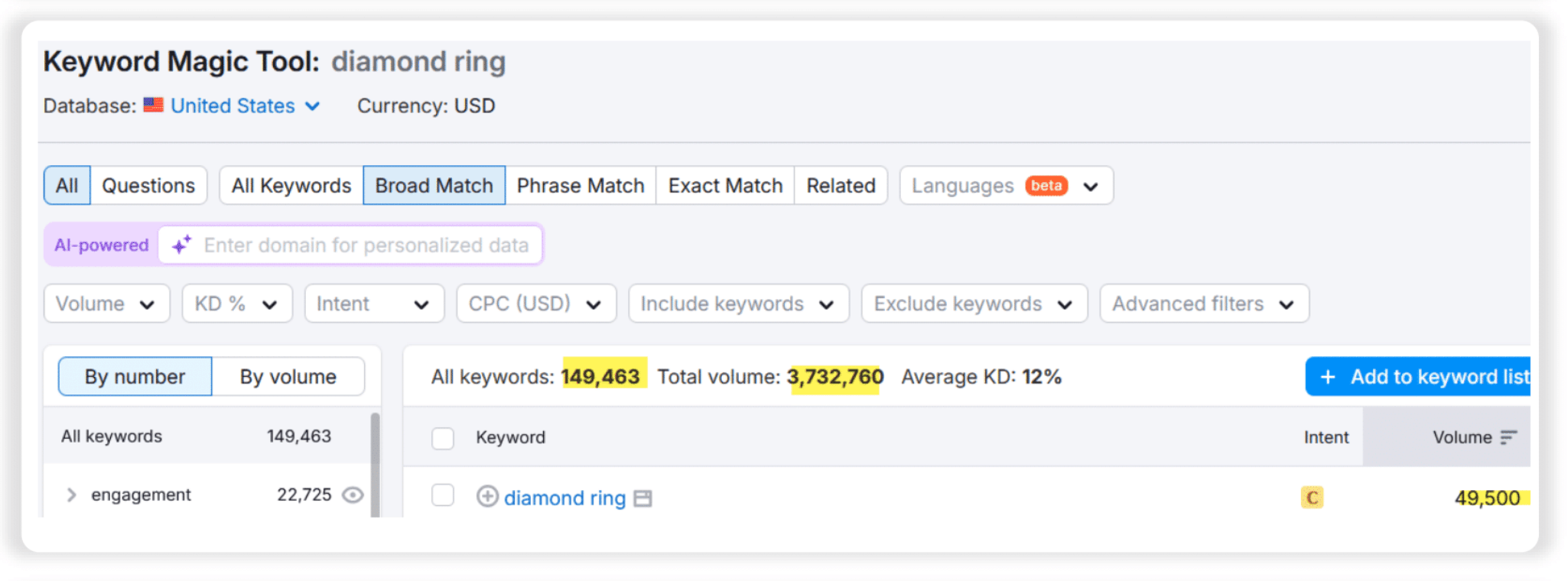
As for the head term “dog food,” it gets 110,000 searches a month, but the total search volume for all dog food-related queries reaches over 10.4 million searches, distributed across 401,000 keywords.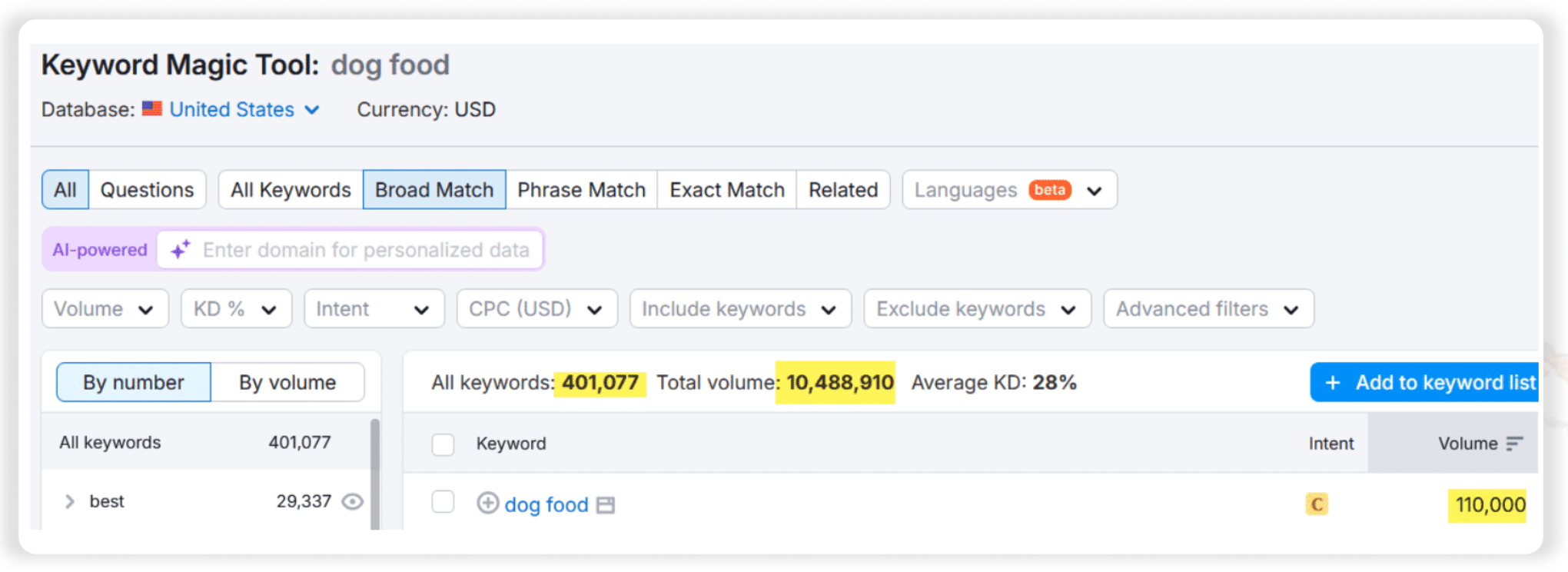
As you can see, head terms make up less than 2% of the total search opportunity. That leaves 98% of potential search traffic scattered across a multitude of specific long tail keywords.
In fact, we estimate Amazon drives nearly 47% of its non-brand organic traffic through long tail keywords. 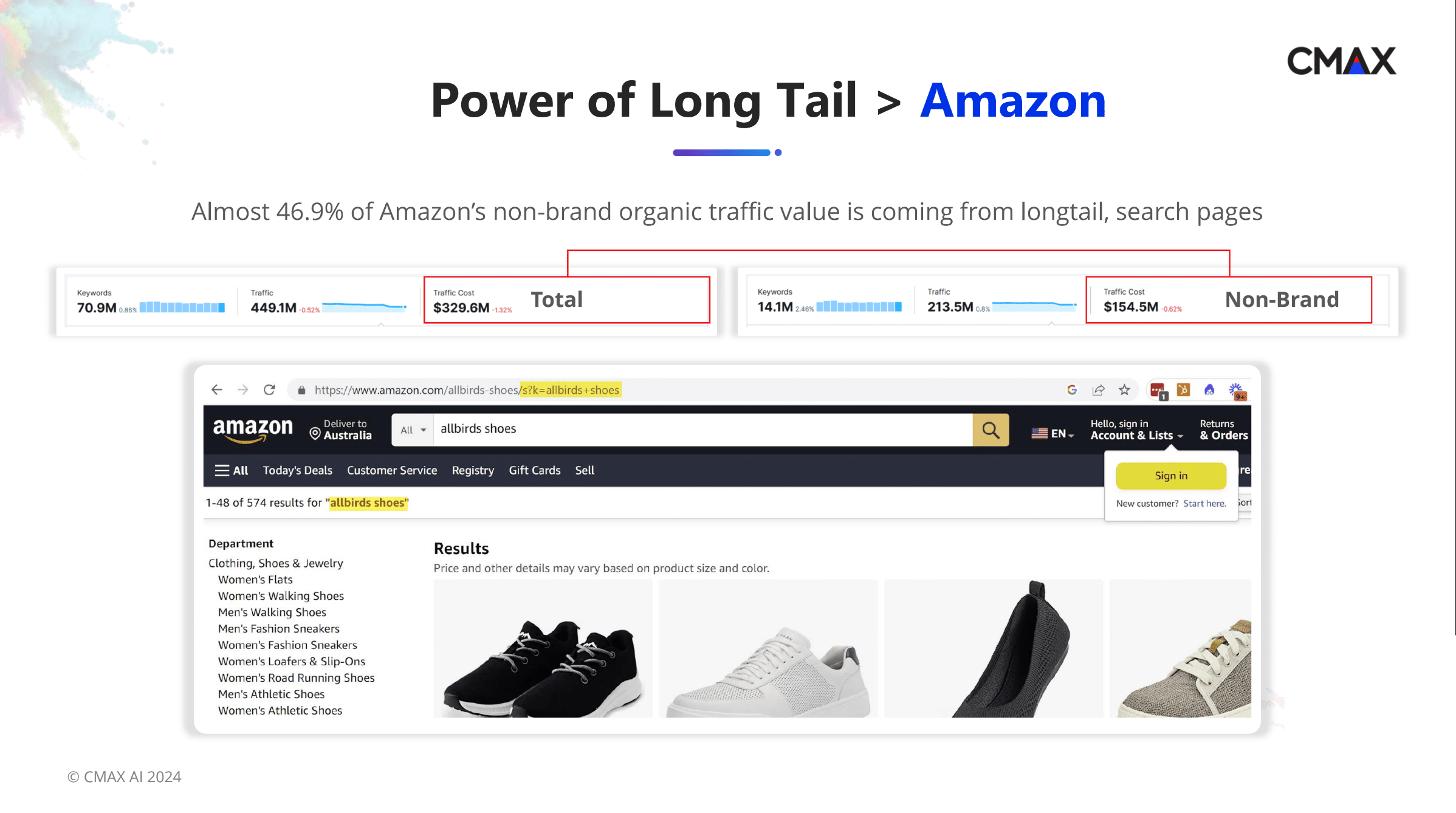
This is old news for Google Ads practitioners who have known for years that if you drill down and look at the actual search terms that drive clicks and conversions the bulk of them are from the long tail.
Google recognized the potential of long-tail keywords early on, which is why, starting in 2014, it began to shift away from allowing advertisers to explicitly target terms using exact match.
Advertisers who adopt this approach are able to capture a wide range of search inquiries and user intents. Using specific and varied search terms, they can expand their reach and reach potential customers.
And it all makes complete sense; broadening your digital footprint and aligning your content with your audience’s precise queries allows you to maximize conversion rates.
Even just a handful of keyword variations can capture an impressive amount of impressions and clicks. Couple that with countless one-off search queries that can collectively contribute to your traffic, and you’ve got yourself a goldmine for opportunity.
But here’s the problem: many businesses consider content to be the most difficult part of SEO, above things like technical work or dealing with algorithm changes.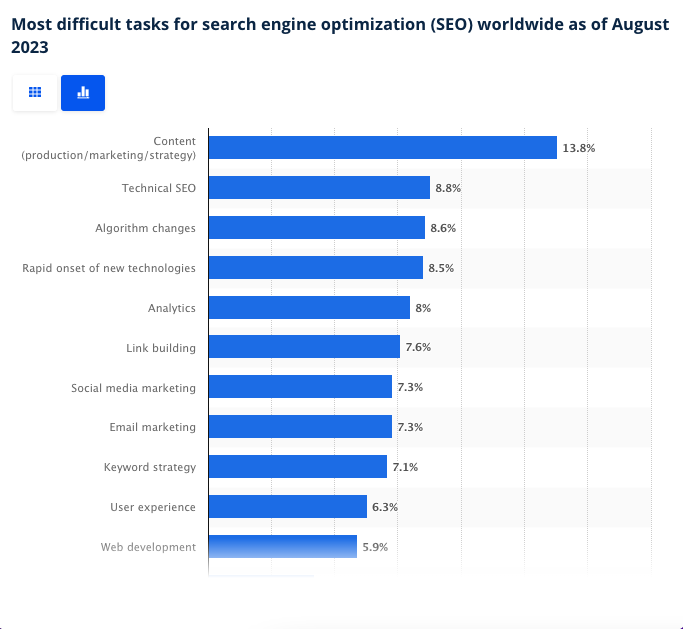
Source: Statista
It’s easy to see why. Manual content creation methods simply can’t keep up with the increasing demand generated by an ever-growing list of search queries, especially the long tail ones.
So what do many people do?
Give up, and revert their focus to the easier, yet overcrowded head terms.
Or, they use programmatic SEO (also known as pSEO).
Programmatic SEO automates previously manual SEO processes. It optimizes websites for long-tail queries, which is essential for scaling organic traffic.
But remember, effective programmatic SEO requires more than just content generation.
To be truly effective, a solution needs to do more than just churn out content.
For starters, you need a unified platform that can actually scale. Stitching together multiple tools is a surefire way to create frustration and inefficiency. What you really need is a single programmatic SEO solution that handles everything – from content creation to re-optimization (yes, because those pages need to continually rank) – in one streamlined system.
Accuracy and compliance are crucial.
Generating thousands of content pieces isn’t enough for real SEO success. Accuracy and compliance are critical, especially if your content needs to reflect your brand’s voice and stay legally compliant. A reliable programmatic SEO platform ensures that every piece of content is unique, brand-safe, legally sound, and meets your exact standards every time. It should incorporate rigorous quality checks and allow for customization to adhere to industry regulations and brand guidelines.
Ease and speed of deployment accelerate ranking success.
Next, consider how easy it is to get your content live. Speed and simplicity matter. The quicker you can deploy content, the sooner you’ll rank. Delayed deployment can result in missed opportunities and give competitors an edge.
An efficient programmatic SEO platform simplifies the publication process and enables you to respond rapidly to market trends and consumer demands.
Long-term visibility ensures ongoing SEO success.
Finally, visibility over the long haul is crucial. Sure, fast results feel good, but they’re only valuable if they last. Search engine algorithms are constantly evolving, and staying atop rankings requires ongoing effort. Your programmatic content should continue to rank well, month after month, which involves regular updates, performance monitoring, and re-optimization.
The reality: most programmatic SEO platforms fall short.
Unfortunately, the very attributes that make a programmatic SEO platform truly effective are exactly where most fall short. Many platforms lack the scalability, integration capabilities, or compliance features necessary for success.
| #1: Programmatic solutions have scalability constraints. | Most programmatic solutions still require manual effort (e.g. manual stitching of content), leading to bottlenecks in scaling SEO content efficiently. |
| #2: Programmatic content struggles with quality and compliance. | Many content generation platforms struggle to uniformly apply regulatory standards and sustain a consistent brand voice across all content. |
| #3: Programmatic SEO solutions require complex deployment. | Conventional tools often necessitate intricate setup processes and complex coding. They might even necessitate an overhaul of current systems. |
| #4: Programmatic content becomes obsolete quickly. | Many programmatic SEO solutions fail to dynamically adjust to evolving market trends and user insights because the content is static. |
So, how do these limitations impact the effectiveness of current programmatic SEO solutions?
Let’s take a closer look at real applications, many of which gave me valuable insights in identifying where these solutions excel and where they fall short in meeting the complex demands of at-scale programmatic SEO.
| Problem | Inadequate capacity to manage extensive SEO operations efficiently, often leading to bottlenecks. |
Other programmatic SEO platforms and approaches often trap businesses in a cycle of inefficiency.
I recently watched a demo for a content generation system using Make.com, claiming to cut production costs from $50-$100 to just pennies. While impressive on the surface, a closer look reveals the core problem many businesses face with programmatic SEO: it’s not truly fully automatic.
Just take a look at this overview of the “end-to-end content generation system.”
Source: Nick Saraev on YouTube
The workflow starts with Typeform to collect content details (title, keywords, links) from the user. 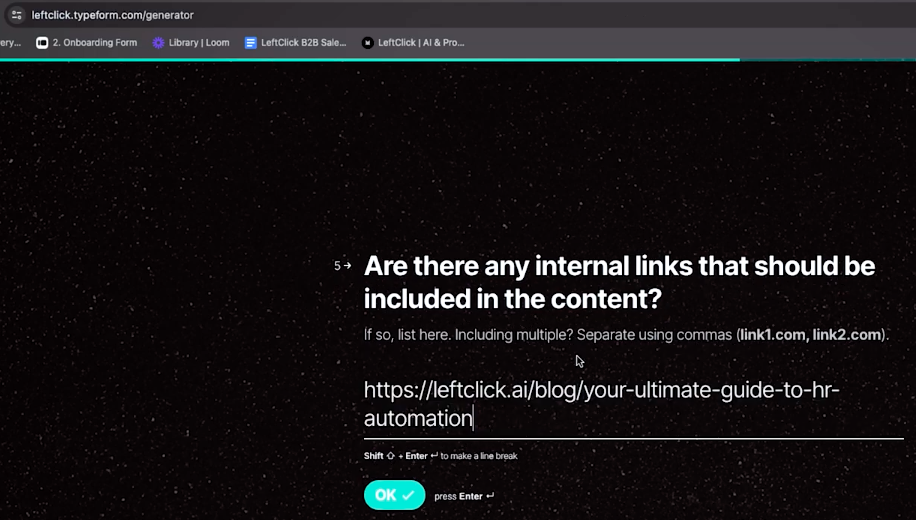
Source: Nick Saraev on YouTube
That data then gets passed to Google Sheets, which acts as the central hub for everything.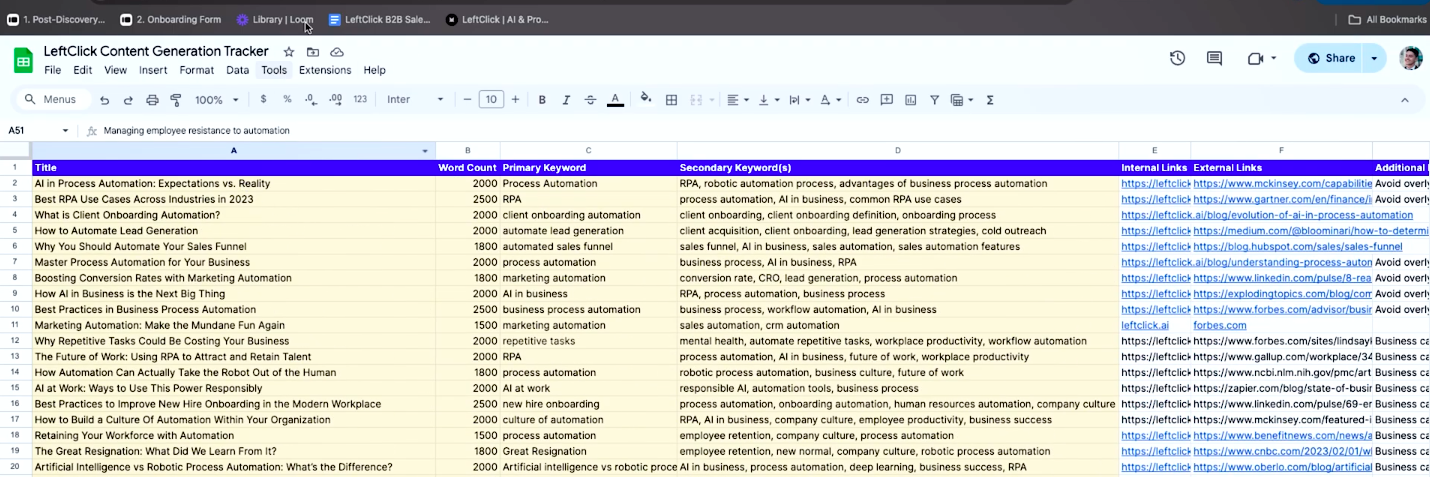 Source: Nick Saraev on YouTube
Source: Nick Saraev on YouTube
After that, the content is generated in sections using OpenAI and then exported into a Google Doc.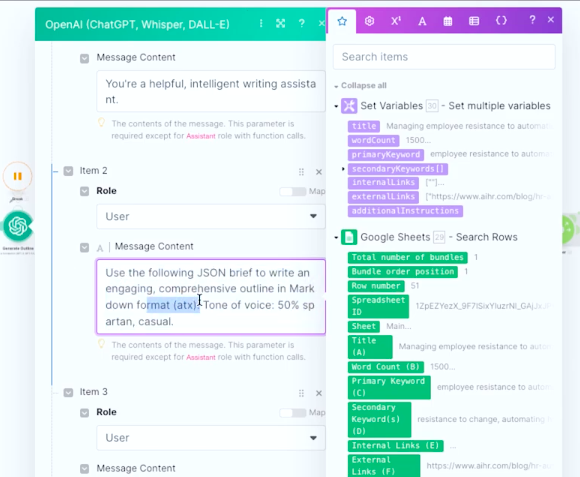
Source: Nick Saraev on YouTube
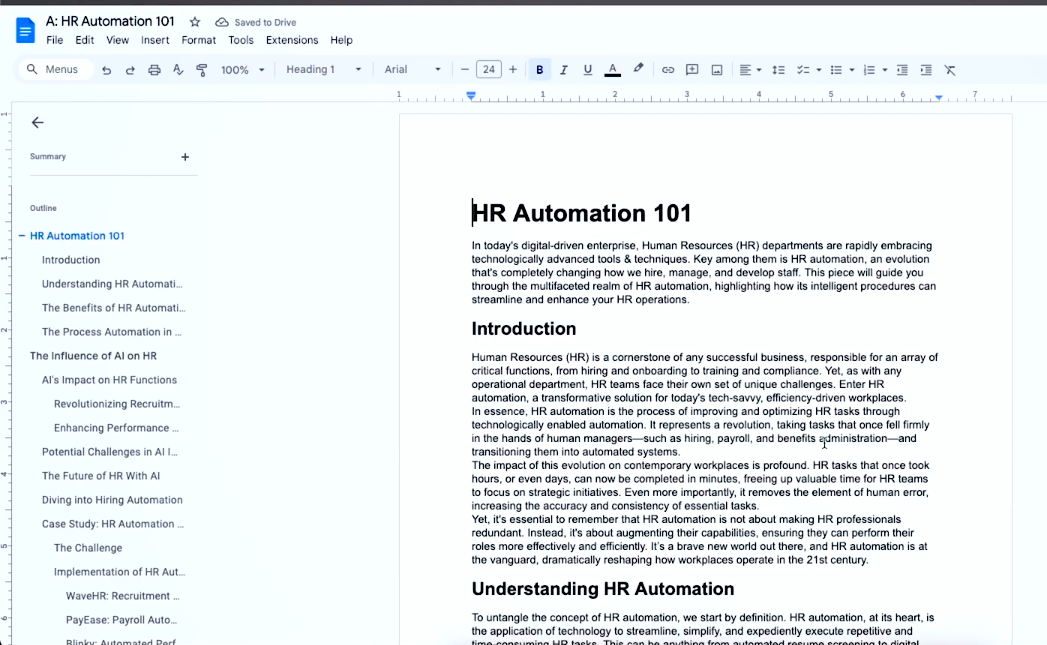
Source: Nick Saraev on YouTube
Throughout the process, the creator keeps hitting issues like failed webhooks, forcing him to step in and rerun things manually. Even when everything’s working, he’s still manually setting up keywords, internal links, external links and giving extra instructions.
The final step of getting the content onto the blog requires yet another tool, adding more complexity and making the process feel clunky and disconnected.
Byword.ai is another platform that promises to streamline content generation, but like others, it still comes with its own limitations. Byword is essentially powered by GPT-4, which means that at its core, it’s just an extra layer on top of what ChatGPT can already do.
Here’s a screenshot from YouTube where one of Byword’s founders discusses how to use it for generating content with keywords.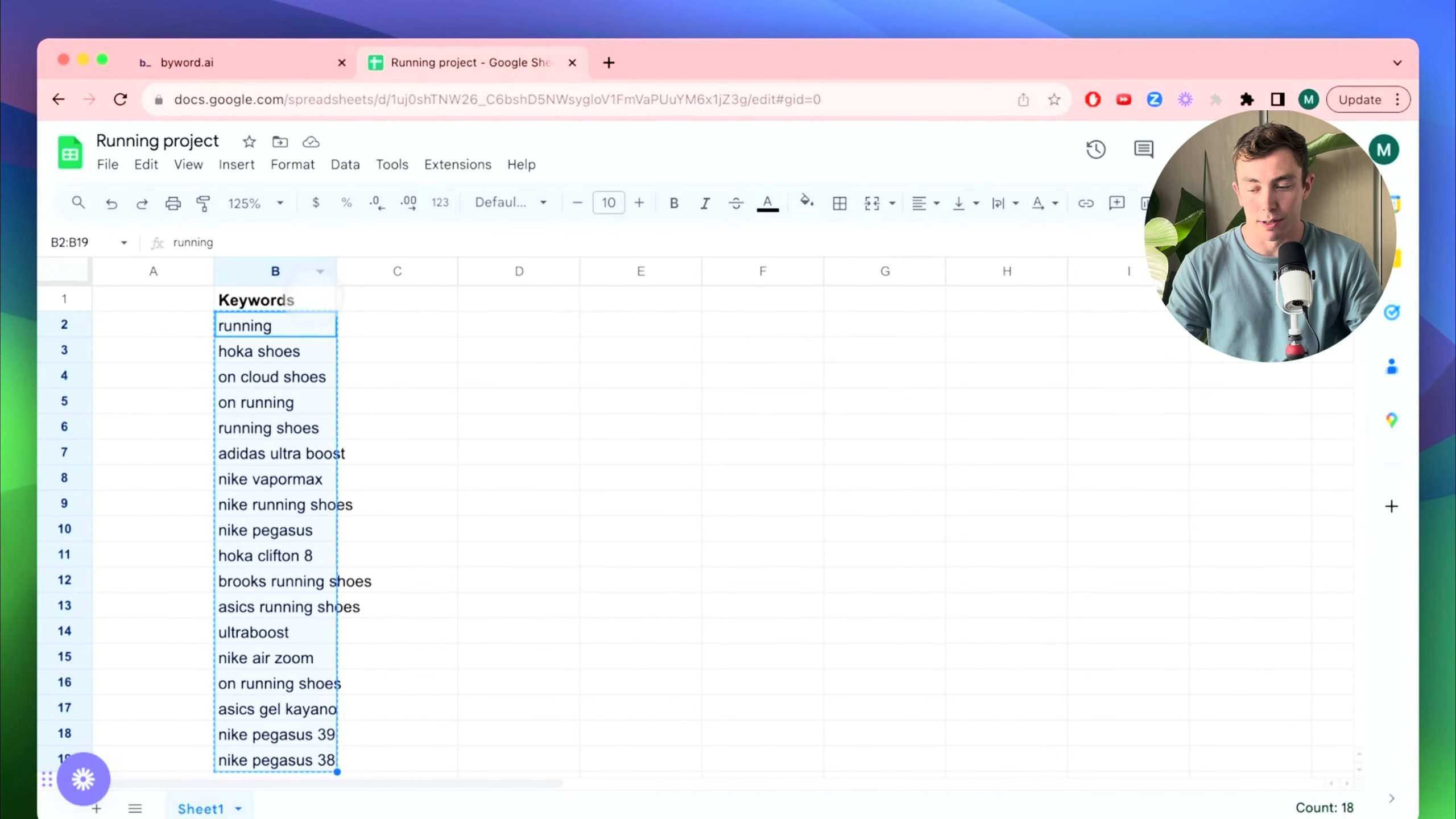
Source: Byword on YouTube
Relying on Google Sheets to manage keywords may not seem like much of an inconvenience at first, but it still adds more manual work and creates a dependence on external tools. With Byword, you’re also juggling credits, which limit how much content you can generate at once.
These examples show how a patchwork of tools and manual fixes slows everything down. Deployment drags, technical hiccups pile up and you end up troubleshooting instead of scaling.
The Theory of Constraints tells us that a system is only as strong as its weakest link. And in this case, the weak link is the lack of integration. These scattered workflows create bottlenecks that make it impossible to hit the speed and scale needed for serious SEO growth.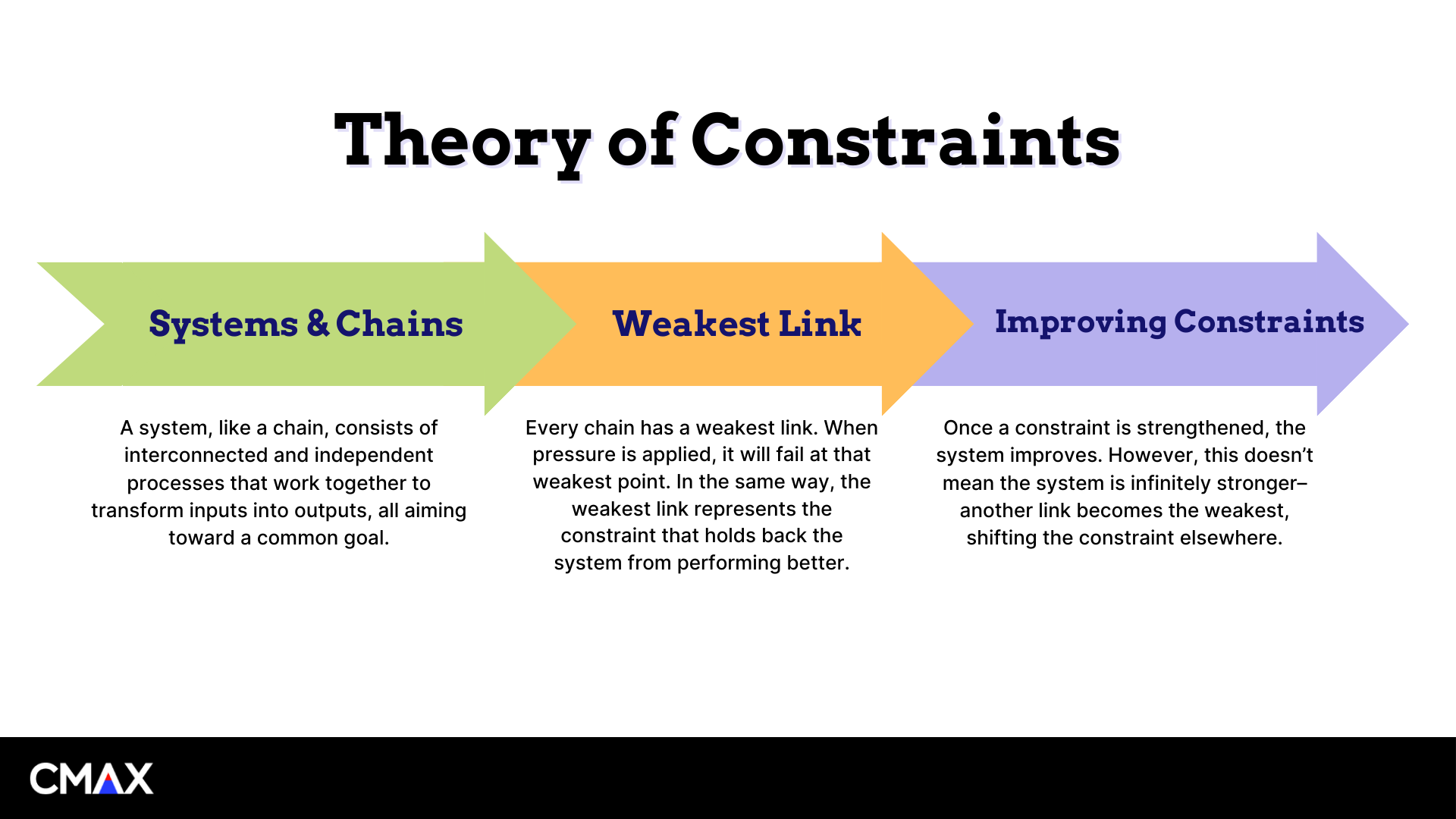
Without fully automating and integrating everything, businesses end up with a half-baked version of programmatic SEO. The right programmatic SEO setup removes these bottlenecks, integrating content generation, internal linking and optimization into one cohesive, scalable system.
There are many different types of effective programmatic SEO strategies out there, so what offers a solution?
| Limitations of Other Programmatic SEO | How CMAX Overcomes This |
| Scalability Constraints: Most programmatic solutions still require manual effort (e.g. manual stitching of content), leading to bottlenecks in scaling SEO content efficiently. | Hyper Scalability: CMAX removes the need for human effort in the content scaling process, thus creating hundreds or even thousands of content efficiently. |
CMAX is the ultimate programmatic SEO platform and the only technology you need, built by our digital marketing agency to turbocharge results for your business.
Automation is the heart of CMAX’s approach to scalability. Our proprietary technology is capable of generating a vast range of content, from hundreds to millions of pages, each optimized for SEO and crafted to engage specifically targeted audience segments.
What makes this feature so powerful is its ability to scale without requiring proportional increases in manual labor or oversight, thus breaking the traditional trade-off between scale and resource allocation.
Streamlining operations for strategic focus
With CMAX taking the wheel on routine SEO tasks, your team is free to focus on what they do best-strategizing and innovating. From manual oversight, your attention is transformed to strategic focus, thereby enhancing your productivity, allowing your team to tackle new challenges and opportunities that come with business growth.
CMAX is the next-generation solution for businesses that demand more than just content at scale – they need content that resonates, performs and evolves-and autonomous right where it needs to be.
You may be wondering if this level of automation compromises quality, and if we’re talking about any other programmatic SEO solution, you’ve got every right to be concerned.
| Problem | Many platforms struggle to uniformly apply regulatory quality standards and sustain a consistent brand voice across all content. |
One of the reasons many SEO content agencies fail is that they rely too heavily on popular large language models (LLM) to produce content.
Take ChatGPT, for example. It’s an incredibly powerful tool for generating content at scale. But like most AI tools, it struggles with “hallucinations” and you still need human intervention to fact-check the content properly. Plus, significant fine-tuning is necessary to make sure the output aligns closely with your specific brand and industry standards.
If you fail to validate the outputs of these LLMs, you could end up publishing content that’s not accurate or compliant, which could lead to regulatory penalties or a loss of trust.
Check out this post on LinkedIn by Bjorn Austraat with a screenshot that highlights how ChatGPT can get fairly confident about something so wrong.
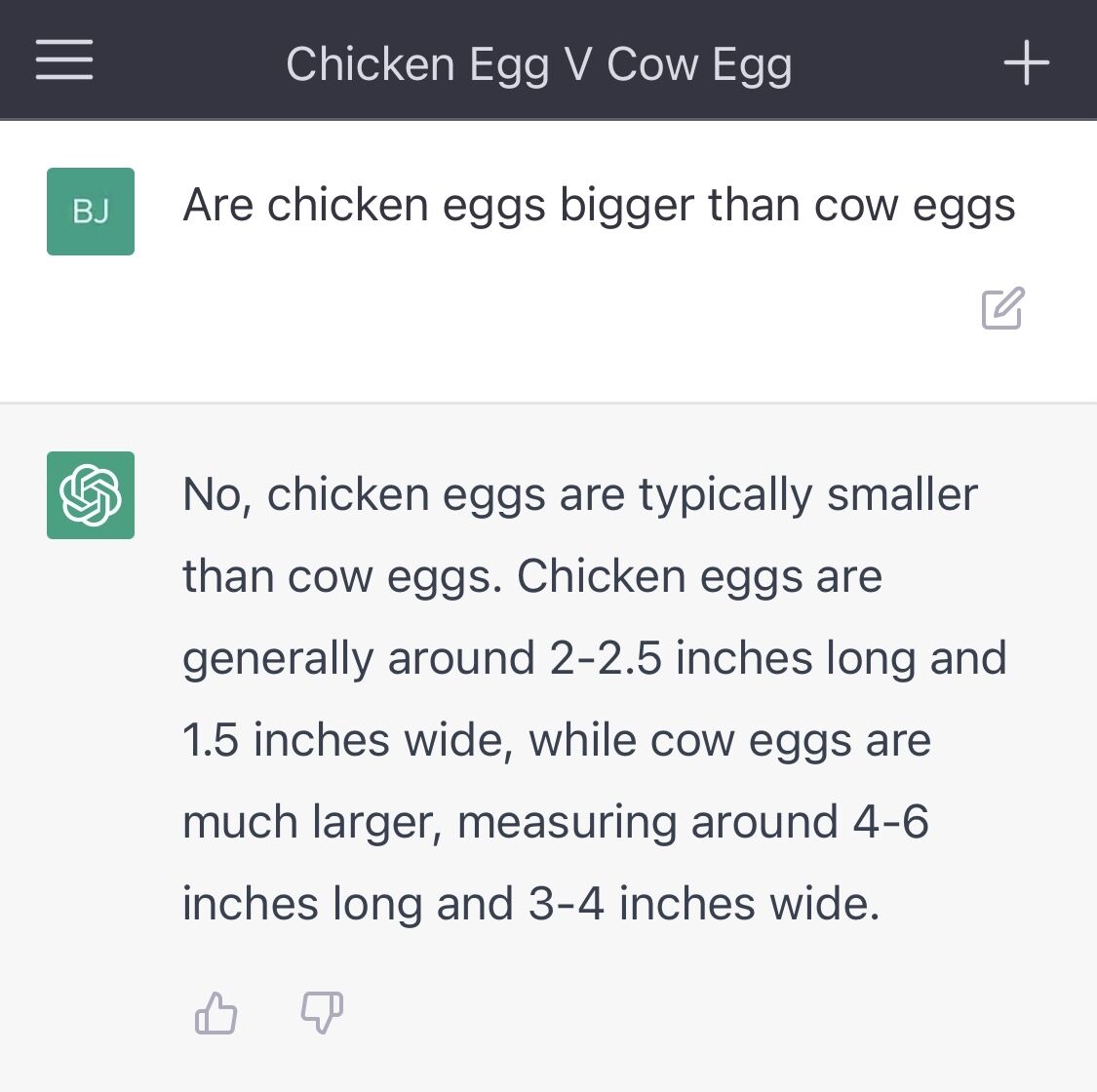
Source: Bjorn Austraat from Linkedin
SEO agencies may try to tackle the challenges of quality and compliance by relying on a range of extra tools.
Grammarly Business is a go-to for many in keeping content clean and consistent. But while it helps with grammatical accuracy across large volumes of text, its autocorrect features may sometimes be overly aggressive.
Users report that Grammarly can misidentify non-errors, suggesting fixes that actually degrade the quality of writing rather than improving it.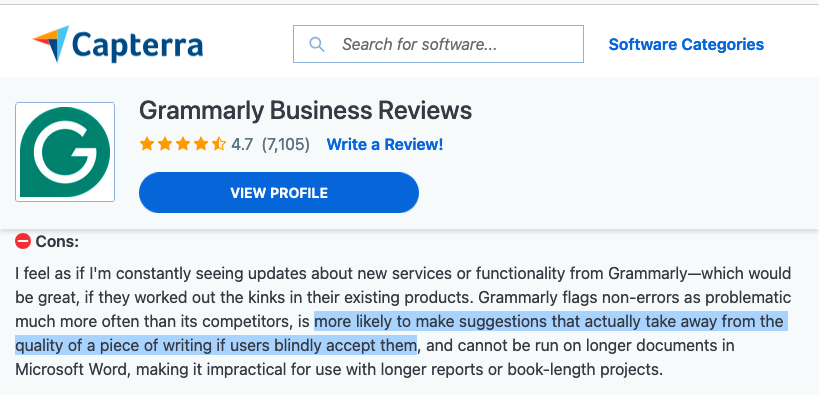
Source: Capterra
Another tool I found that others use in their SEO processes is Perplexity.ai, a chatbot-like platform that integrates real-time web searching capabilities. In one YouTube tutorial, after generating a blog post outline with Make.com and OpenAI, the uploader created a set of prompts, which he fed into Perplexity.ai to fact-check claims and pull supporting data from the web.
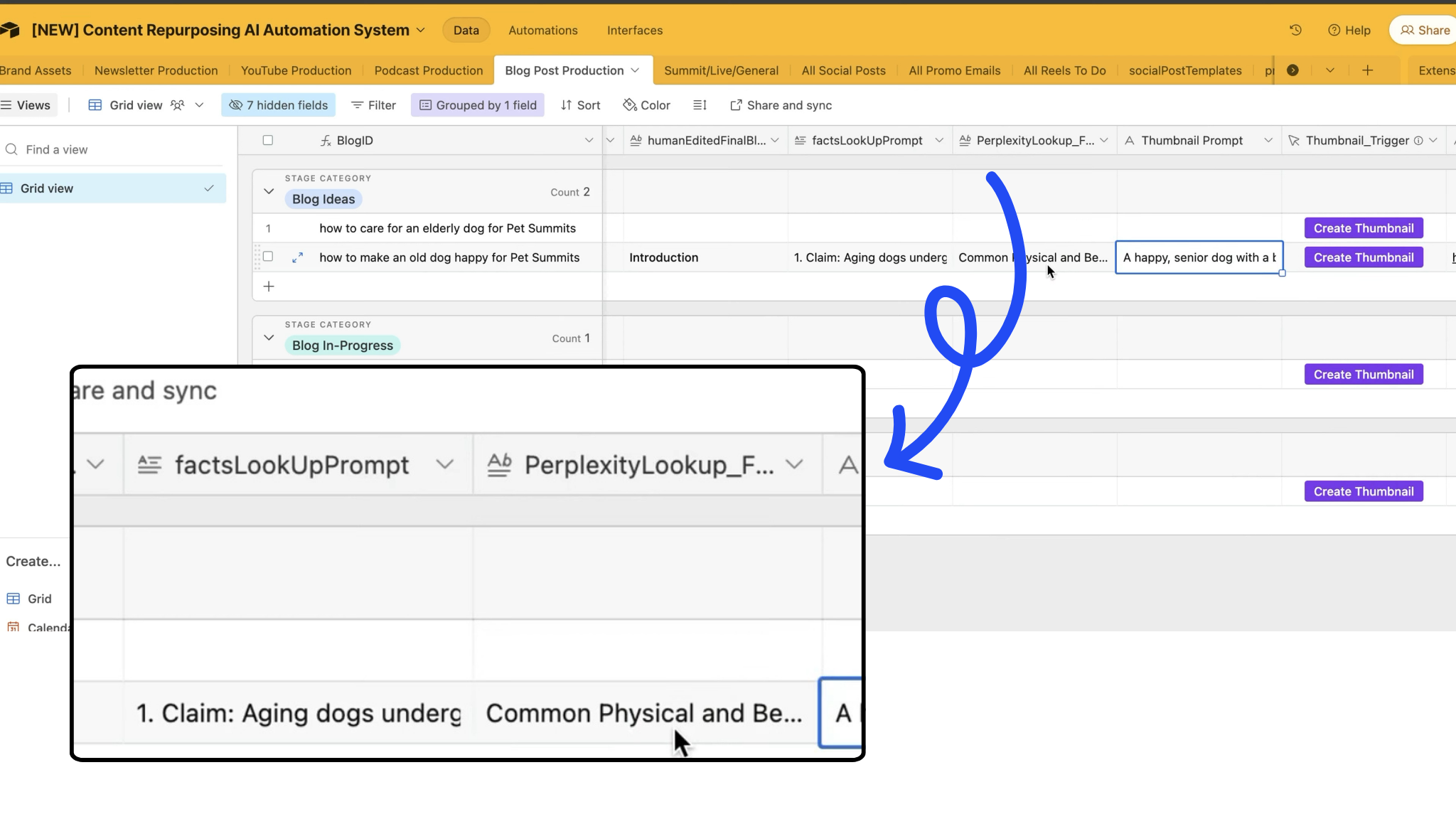
Source: Mitch Asser on Youtube
But here’s the catch about Perplexity: it’s not always pulling from reliable or authoritative sources.
I want to show you an excerpt from a blog where the author ran a travel-related query, “Cultural festivals in Kyoto, Japan,” through the platform.
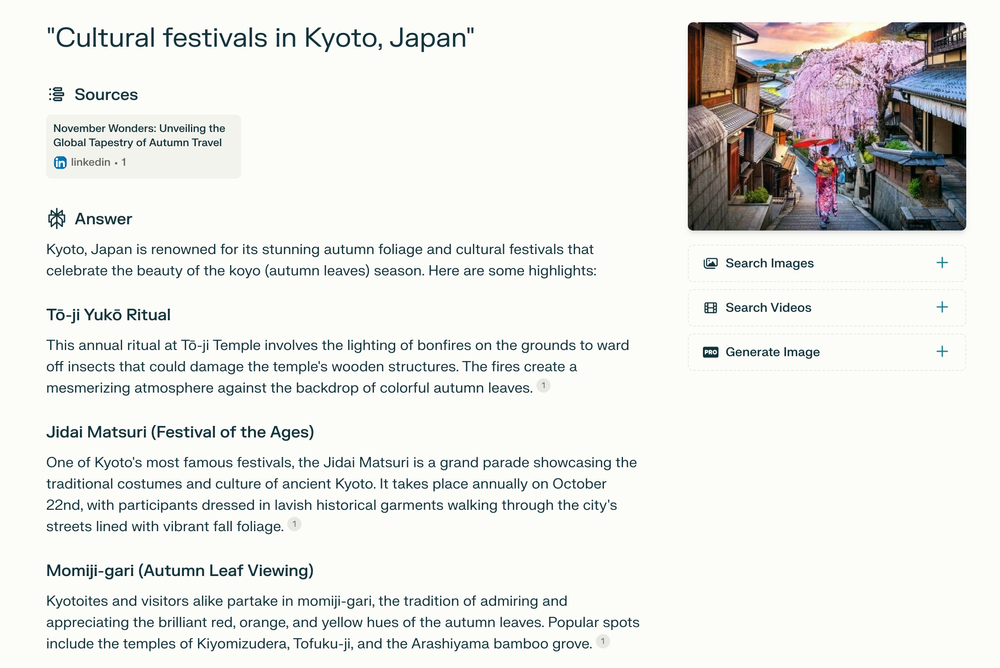
Source: GPTZero “Perplexity Investigation”
The only source Perplexity used to generate the response was an entirely AI-generated LinkedIn article, missing more credible sources.
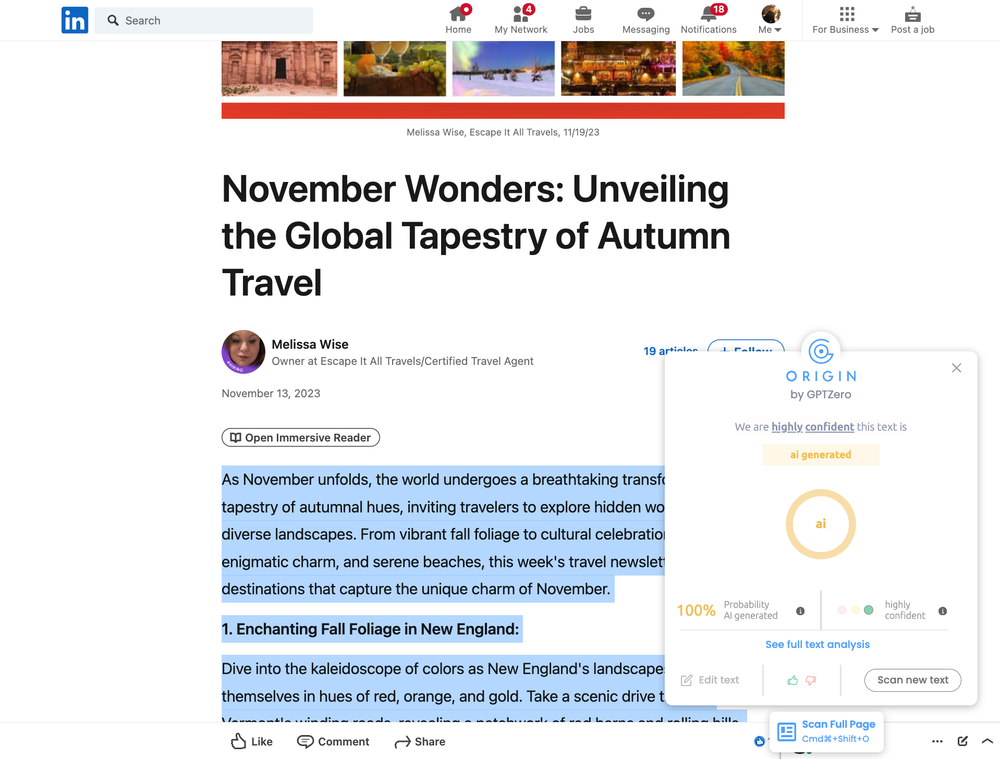
Source: GPTZero
Then there’s Copyscape, widely used to ensure content uniqueness and guard against plagiarism. But it could often flag common phrases or properly credited lists as plagiarism, generating false positives. This leads to unnecessary alerts and forces users to sift through irrelevant results just to find actual duplicates.
Ultimately, without the right programmatic SEO technology, you’re bound to face significant challenges.
These models aren’t trained on your specific brand. It doesn’t know your unique tone, industry-specific language and SEO requirements. Without this customization, the content could lack depth, feel repetitive or miss the mark on critical brand consistency.
With over 180 million users tapping into ChatGPT alone (Source: AIPRM), as well as 7.7 million paid subscribers (Source: Yahoo), there’s a high chance that different businesses targeting the same topics are generating very similar, if not duplicate, content. This can be a big problem for SEO because search engines reward original, fresh content.
If your content looks too much like the ones from your competitors, it could hurt your rankings instead of helping them.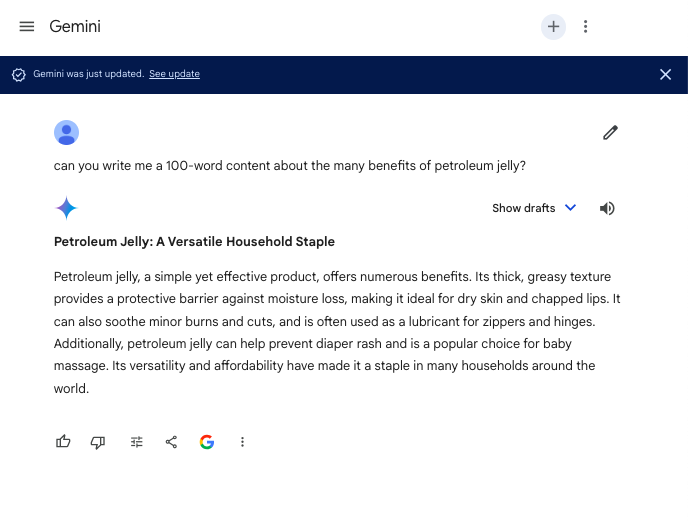

But what if we told you CMAX can turn things around?
| Limitations of Other Programmatic SEO | How CMAX Overcomes This |
| Compliance and Brand Inconsistency Many platforms struggle to uniformly apply regulatory standards and sustain a consistent brand voice across all content. |
Rigorous Compliance and Brand Integrity: Powered by controlled training data, CMAX customizes large language models (LLMs) specifically for your content, ensuring each piece-from 1,000 to 1,000,000 pages-meets your exact industry standards without fail. |
Rather than relying on unpredictable third-party platforms, we custom large language models (LLMs) trained exclusively on the content we create for you, vetted by you. This approach prevents common issues such as brand misalignment and inaccuracies typical of conventional AI tools.
That means every piece of content we produce-whether it’s 1,000 pages or 1,000,000-adheres to all your industry requirements. No surprises, no compromises.
Before CMAX kicks into high gear with large-scale content creation, it’s the human touch that sets the foundation.
Our expert team of human SEO copywriters works closely with yours to get everything just right. We ensure the content aligns with your brand’s message and that it checks all the necessary boxes. Once that’s been signed off on, this human-crafted content serves as a benchmark for all subsequent automated production.
With this groundwork in place, CMAX efficiently scales content production and is able to maintain quality and consistency from the first piece to the millionth. Our commitment to combining human oversight with advanced AI ensures that even at large volumes, the system has enough guardrails to prevent the automated content from going off track.
But you’re likely wondering if this level of sophistication comes with a degree of complexity that’s difficult to execute.
This leads us to the next limitation.
| Problem: | Conventional tools often necessitate intricate setup processes and complex coding. They might even necessitate an overhaul of current systems. |
Theoretical promise vs. practical pitfalls
Programmatic SEO may sound ideal in theory, but the reality of implementing these solutions often leads to frustration due to their complexity and the insufficient payoff. The setup of such strategies generally demands a high level of technical know-how, which many teams lack.
Coding (and non-coding) complexities
Many programmatic SEO agencies and systems rely on complex, highly technical solutions that demand significant coding expertise. Some build custom scripts, APIs or intricate workflows to integrate content generation tools with SEO platforms. 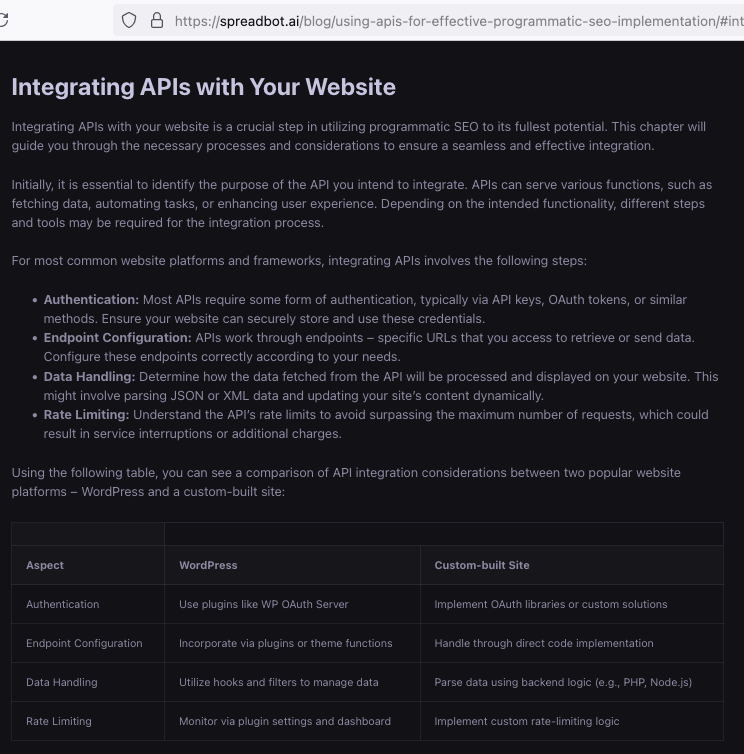
Source: spreadbot.ai
One good example here is Zapier, which relies on a complex programmatic SEO strategy to power thousands of highly targeted pages. Each page is designed to solve a specific problem, like integrating two apps (e.g., “Google Sheets and Trello integration”). They use a database-driven system that dynamically generates pages for every app combination that a user would search for.
Here’s where it gets complicated: They use a separate SaaS platform to create two-way integrations between platforms like Webflow, Airtable and Postgres. Sure, there’s no coding needed, but it’s far from simple.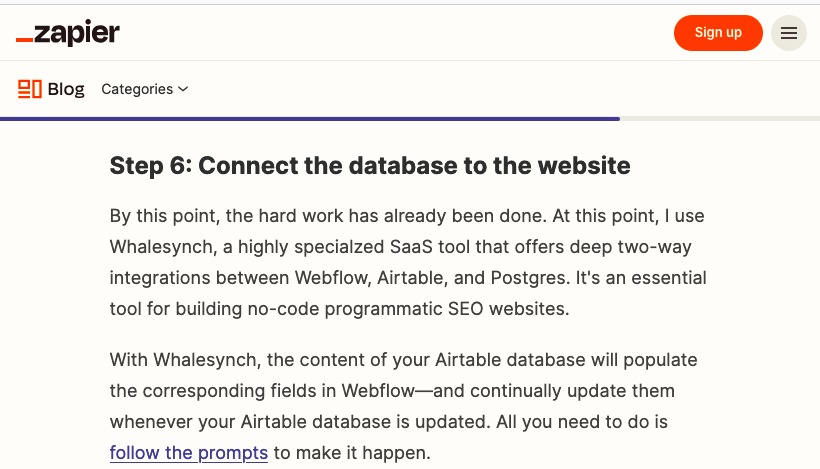
Source: Zapier
For every page to work correctly, you’d have to ensure that Airtable and Webflow are perfectly in sync, mapping every field between the two platforms, setting up API keys and managing data flows. Even once everything is connected, you still need to monitor the system closely to catch errors and syncing issues.
Continuous adjustments required
SEO is dynamic, requiring ongoing adjustments to align with changing search engine algorithms and market trends.
To give you a better idea, many agencies try to automate content generation and optimization using frameworks like Google Cloud Functions or AWS Lambda, which, as you can probably tell, will come with a technical burden. Some even use custom web crawlers or complex data pipelines to push content into CMS platforms, adding layers of complexity and slowing down execution.
These methods need nonstop coding know-how, constant juggling between development and marketing and plenty of upkeep just to keep things on track.
The more complex the system, the more time-consuming it becomes to manage and update, making it difficult to respond quickly to SEO changes. What should be a time-saving solution often turns into a bottleneck, slowing down your ability to scale and react in a fast-moving digital landscape.
Platform-specific constraints
Conventional programmatic SEO solutions often come with strings attached. They’re designed to work with specific platforms or require integration with a particular CMS, forcing you to adapt your existing setup or, worse, migrate to a whole new system.
Check out how Ahrefs suggests publishing programmatic content to your website: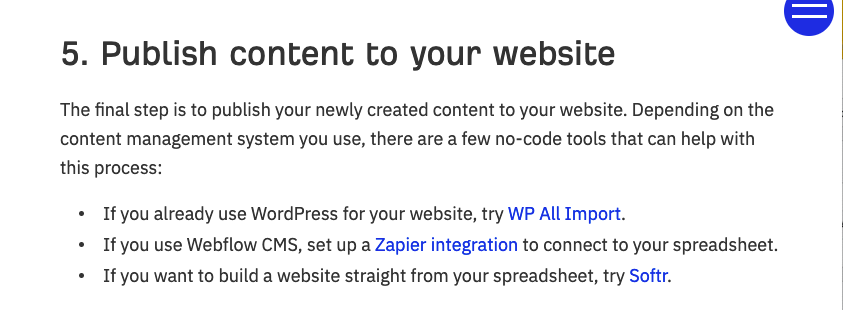
Source: Ahrefs
If you’re not using the CMS they’re built for, you either miss out on the solution entirely or have to make some disruptive changes just to fit their mold.
Impact on business operations
Your programmatic SEO solution should seamlessly fit into your existing operations without necessitating a complete overhaul. The aim is to enhance and empower what’s already working effectively for your business, ensuring that the SEO strategy works for you, not against you.
We believe the key to scalability goes beyond automation, but exponential execution. That can only be done with a platform that allows you to focus on driving growth and innovation rather than getting bogged down by the limitations of your SEO tools.
The principle of parsimony, or Occam’s razor, tells us that the best explanations are the most simple and elegant.
And that’s CMAX.
| Limitations of Other Programmatic SEO | How CMAX Overcomes This |
| Complex Deployment: Conventional tools often necessitate intricate setup processes and complex coding. They might even necessitate an overhaul of current systems. | Simplified Implementation: CMAX streamlines your SEO strategy with a straightforward, quick-to-deploy solution that integrates seamlessly with any CMS, requiring just two lines of code to implement on your website. |
We know you’re looking for a straightforward, quick-to-deploy SEO solution that doesn’t sacrifice effectiveness. That’s exactly why we designed CMAX-to seamlessly integrate into your workflow without the typical complexities of SEO software.
Unlike other SEO tools that demand extensive manual intervention and the coordination of multiple platforms, CMAX offers a single, integrated platform that manages everything from content generation to SEO optimization.
Once we’ve worked together to finalize the SEO terms you want to target at scale-determining the pages that need to be built-the technical setup is quick. Just add two lines of code to your existing pages or templates, and CMAX takes care of the rest. The code is compatible with any CMS, including WordPress, Shopify and more.
Here’s how it works:
Step 1: We help you identify high-value keywords to target through content.
Step 2: Add our JavaScript code to your new or existing pages.
Step 3: CMAX automatically injects contextual, self-optimizing content and builds internal links to maximize SEO performance.
In fact, we’ve had clients where CMAX became fully operational within four to six weeks, far faster than conventional SEO methods that often take as long as six months.
However, we know that as your ambitions grow, so do your marketing objectives. You’re also concerned about whether there are any tools out there designed to adapt as quickly as you recalculate strategies for your business.
| Problem | Without dynamic and adaptive post-deployment strategies, most programmatic SEO solutions falter as the generated content quickly becomes obsolete, therefore requiring a tedious, manual process to refresh the content. |
A lot of programmatic SEO campaigns lose their steam after launch. But why is that?
Because once the content is live, search algorithms evolve and competitors continuously introduce new content. Before you know it, your pages are suddenly slipping in the rankings. Even top-performing pages can lose their search rankings post-deployment over time as a result.
On top of that, search habits change. The keywords that once brought in tons of traffic might not be as effective anymore. This is why re-optimizing content is absolutely essential to any programmatic SEO strategy.
The fact of the matter is that search engines love fresh content. In fact, fewer than 5% of websites stay on the first page for a whole year (Source: Semrush). That’s a big wake-up call for anyone thinking they can “set it and forget it” when it comes to SEO.
Unfortunately, many programmatic SEO how-tos online and agencies themselves stop there-they leave you hanging after the initial deployment. Why? Either they don’t have a plan for re-optimization or they’re doing it manually and don’t want you to know it.
Take, for example, these resources below. While these best practices-like monitoring page speed, using content marketing or tracking bounce rates-are certainly valuable, they fall short when it comes to handling the sheer scale of programmatic SEO. 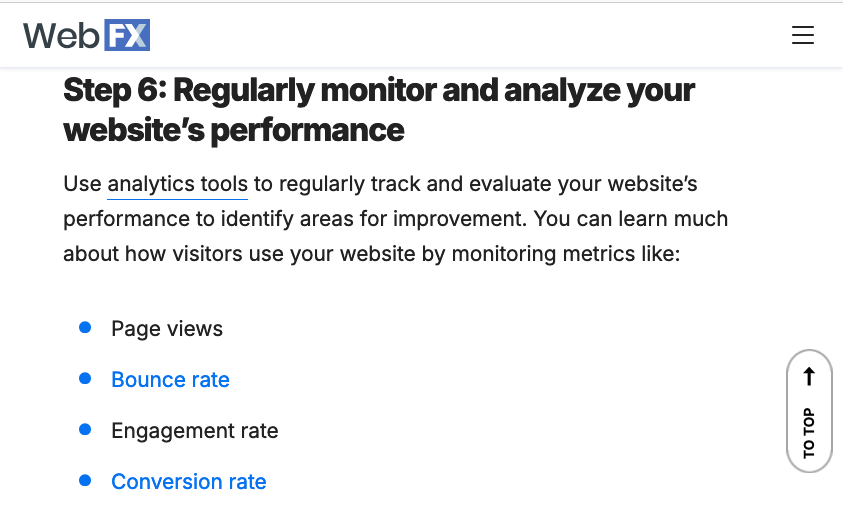
Source: WebFX

Source: Market Brew
Manually reoptimizing just isn’t feasible when you have thousands of programmatic content pages. Traditional tools just aren’t designed to handle re-optimization at scale, leaving you with an outdated workflow that can’t keep up with ever-changing search trends.
And if that wasn’t enough, some agencies resort to article spinning. Tools like Spinbot or The Best Spinner are used to automatically rewrite content in an attempt to maintain freshness with minimal effort.
I’ve even tried it myself. Notice how the words are shuffled around, but the message stays the same?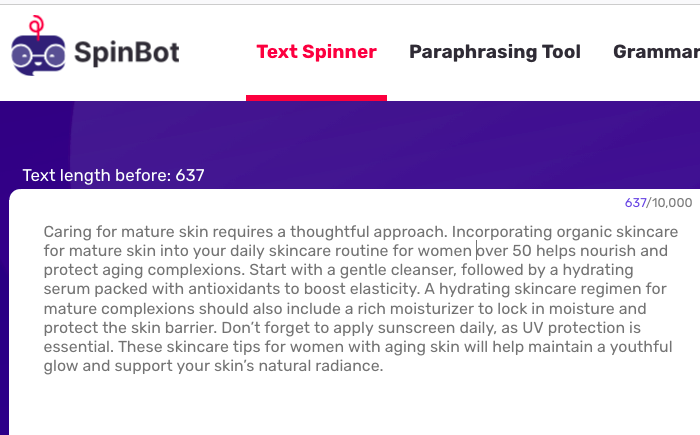
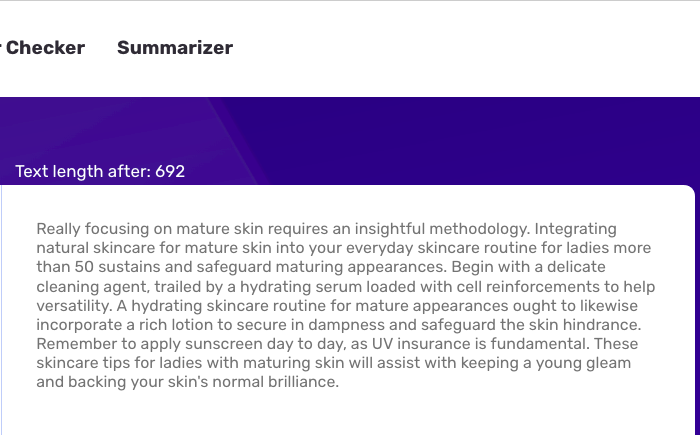
The result of these spinners is often content that lacks authenticity and fails to engage the audience. Spun content might look different, but it doesn’t offer real value – and search engines are getting smarter at recognizing these superficial changes.
What’s the solution?
| Limitations of Other Programmatic SEO | How CMAX Overcomes This |
| Static content, static growth. Without dynamic and adaptive post-deployment strategies, programmatic SEO solutions falter as the generated content quickly becomes obsolete. |
Self-optimizing machine. CMAX can keep up with your changing keyword strategies, with autonomous self-optimizing protocols and automated intelligent cross-linking to meet your evolving SEO demands. |
Unlike other systems, CMAX isn’t just a one-time content machine.
While many solutions create pages and leave them static, CMAX uses machine learning to continuously update and refine your content so it evolves with ever-changing SEO demands. Search engines prioritize websites that are frequently updated and optimized, and that’s where CMAX shines.
Future-proof scalability with a two-pronged approach to self-optimization
What follows after deploying your content is a thorough analysis of cross-page relationships and user engagement metrics, where we take that information and look into synergistic opportunities to distribute link equity and authority throughout your site.
However, this doesn’t mean we’re simply leaving you with insights and strategies you’d have to execute yourself. In fact, most SEO teams don’t lack insights and will have plenty to say about your site.
But SEO growth isn’t driven by more insights. It’s driven by more action.
That’s why CMAX goes a step further by also automatically implementing these strategies for you, on top of offering valuable insights.
Now, here’s where it really gets exciting.
Behind the scenes, our proprietary technology autonomously tests and optimizes elements such as headings, keywords and layouts. It adapts and improves based on what works-constantly learning from ongoing results and adjusting strategies with automated intelligent cross-linking.
Conventional SEO often focuses on individual page optimization, which can lead to siloed efforts and limited scalability. In contrast, CMAX focuses on your entire content portfolio. It leverages an advanced team-based (portfolio) optimization strategy, where the performance of your highest-ranking pages actively contributes to uplifting those that are underperforming.
The trick is a holistic approach that transforms isolated successes into collective gains, maximizing your return on investment.
And the best part? All of this can be done without requiring manual work from your team. Best practices are consistently applied site-wide, and it reduces the risk of human error and frees up your resources.
CMAX shifts that focus on your site architecture and creating meaningful connections between related content pieces.
Put this way, search engines get a clear and comprehensive understanding of your site’s thematic structure. This helps address the issue of orphan pages – those isolated pages that receive little to no traffic-thereby enhancing crawlability, discoverability and indexability.
When you’re at the stage where you’re focusing on scale, you also need to think about how to future-proof your SEO. That means fostering an ecosystem where every page supports and enhances the others, you’re building a resilient digital presence that’s equipped to adapt to evolving keyword strategies and market dynamics.
What do you get from all this? Here’s the answer: sustained growth, improved rankings and more time for you to focus on strategic initiatives that drive your business forward.
Here’s a recap of how CMAX holds up against other programmatic SEO solutions.
| Limitations of Other Programmatic SEO Solutions | How CMAX Overcomes This |
| Programmatic solutions have scalability constraints. Most programmatic solutions still require manual effort (e.g., manual stitching of content), leading to bottlenecks in scaling SEO content efficiently. | Hyper Scalability: CMAX removes the need for human effort in the content scaling process, thus creating hundreds or even thousands of content efficiently. |
| Programmatic content struggles with quality and compliance. Many content generation platforms struggle to uniformly apply regulatory standards and sustain a consistent brand voice across all content. |
Rigorous Compliance and Brand Integrity: Powered by controlled training data, CMAX customizes large language models (LLMs) specifically for your content, ensuring each piece-from 1,000 to 1,000,000 pages-meets your exact industry standards without fail. |
| Programmatic SEO solutions require complex deployment. Conventional tools often necessitate intricate setup processes and complex coding. They might even necessitate an overhaul of current systems. | Simplified Implementation: CMAX streamlines your SEO strategy with a straightforward, quick-to-deploy solution that integrates seamlessly with any CMS, requiring just two lines of code to implement on your website. |
| Programmatic content becomes obsolete quickly. Many programmatic SEO solutions fail to dynamically adjust to evolving market trends and user insights because the content is static. |
Self-optimizing machine: CMAX can keep up with your changing keyword strategies, with autonomous self-optimizing protocols and automated intelligent cross-linking to meet your evolving SEO demands. |
Luckily for you, the most advanced solution on the market doesn’t require an army of content creators or complex systems.
Our AI-powered platform, CMAX, is designed to automatically capture the 90% of untapped SEO traffic opportunities that most businesses miss. It accomplishes this like no other existing platform by combining the sophistication of AI and the ease of automation with strategic human insight that allows for limitless growth on autopilot.
You don’t need to settle for SEO strategies that rely on slow, manual processes when you can tap into an automated, high-growth engine.
Visit CMAX.ai today and transform hidden traffic into tangible business growth with the world’s most advanced programmatic SEO solution.